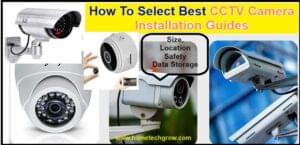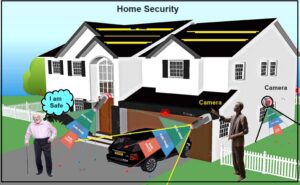Importance of CCTV Camera for Homes
- CCTV (Closed Circuit Television) cameras play a crucial role in enhancing security and surveillance in various settings.
- Here are some key reasons highlighting the importance of CCTV cameras:
Crime Deterrence:
- The mere presence of CCTV cameras can act as a deterrent to criminal activities.
- Potential wrongdoers are less likely to commit crimes when they know they are being monitored.
Evidence in Legal Cases:
- CCTV footage serves as valuable evidence in legal investigations.
- It can help law enforcement identify suspects, establish timelines, and provide crucial details that may be instrumental in solving crimes.
Security Monitoring:
-
- CCTV cameras allow for real-time monitoring of a location, enabling security personnel or homeowners to respond promptly to suspicious activities or emergencies.

Home security with CCTV camera
- CCTV cameras allow for real-time monitoring of a location, enabling security personnel or homeowners to respond promptly to suspicious activities or emergencies.
Productivity and Safety:
-
- In a business or workplace setting, CCTV cameras can help monitor employee activities, promote workplace safety, and deter theft or misconduct.
Traffic Management:
-
- CCTV cameras are commonly used for monitoring traffic flow, managing congestion, and ensuring road safety. They can be employed at intersections, highways, and public transportation hubs.
Prevention of False Claims:
- In both commercial and residential settings, CCTV cameras can help protect against false insurance claims. Having recorded footage can serve as evidence to refute unfounded accusations.
Public Safety in Urban Areas:
-
- CCTV cameras contribute to public safety in urban areas by monitoring public spaces, transportation systems, and critical infrastructure.
- This helps in the prevention and detection of criminal activities.
Retail Security:
-
- In retail environments, CCTV cameras are crucial for preventing theft, monitoring shoplifting, and ensuring the safety of both customers and employees.
- Remote Monitoring:
- With advancements in technology, many CCTV systems allow remote monitoring via smartphones or computers. This feature enables users to keep an eye on their properties or businesses from anywhere in the world.
- Emergency Response:
- In the event of an emergency or security breach, CCTV footage can provide real-time information to emergency responders, facilitating a quicker and more effective response.
- Visitor Verification:
- In residential settings, CCTV cameras at entry points can be used to verify the identity of visitors and enhance the overall security of the property.
- Child and Elderly Monitoring:
- CCTV cameras are sometimes used for monitoring the well-being of children and elderly family members. This is especially relevant in homes where caregivers may need to keep an eye on individuals with specific needs.
- While CCTV cameras offer numerous benefits, it’s essential to balance the use of surveillance technology with privacy considerations and adhere to relevant laws and regulations governing their use.

Selection of Camera
- Selecting the best CCTV camera for your home involves considering various factors to ensure that it meets your specific requirements.
- Here are some key considerations to help you choose the right CCTV camera:
Purpose of Installation:
-
- Determine the primary purpose of installing CCTV cameras.
- Is it for general surveillance, monitoring specific areas, or for deterring potential intruders?
Indoor vs. Outdoor Cameras:
-
- Choose cameras suitable for their intended locations.
- Outdoor cameras should be weatherproof and able to withstand varying environmental conditions.
Resolution:
-
- Higher-resolution cameras provide clearer images.
- Consider at least 1080p (Full HD) resolution for clear details.
- Higher resolutions like 4K are suitable for larger areas.
Night Vision:
-
- Opt for cameras with infrared (IR) or low-light capabilities if you need to monitor your property at night.
- Check the camera’s night vision range.
Field of View:
-
- Consider the field of view (FOV) to determine how much area a camera can cover.
- Wide-angle lenses are suitable for covering larger areas, while narrower lenses focus on specific spots.

View Angle of Camera
Motion Detection:
-
- Cameras with motion detection can alert you to potential threats and save storage space by recording only when motion is detected.
Data Storage
-
- Decide between local storage (SD cards or NVR/DVR) and cloud storage.
- Cloud storage offers remote access to footage but may have subscription costs.
Remote Access:
-
- Choose cameras that offer remote access, allowing you to view live feeds and recorded footage from your smartphone or computer.
- Ensure the system is compatible with your preferred mobile platform.
Two-Way Audio:
- If communication is important, consider cameras with two-way audio.
- This feature allows you to listen and speak through the camera.
Power Source:
- Determine if the camera requires a power source or if it can operate on batteries.
- Wired cameras are generally more reliable but may require professional installation.
Ease of Installation:
- Consider whether you’ll install the cameras yourself or hire a professional.
- Some cameras are designed for easy DIY installation.
Brand Reputation and Reviews:
- Research and choose reputable brands with positive customer reviews.
- This ensures product reliability and good customer support.
Cost and Maintenance
- Establish a cost based on your requirements.
- There are cameras available at various price points, so choose one that fits your needs and budget.
Legal Considerations:
- Be aware of local laws and regulations regarding CCTV installation and ensure your system complies with privacy laws.
- By carefully considering these factors, you can select the CCTV camera system that best meets your home security needs.
How to Select the Best CCTV Camera for Home Security
- Choosing the best CCTV camera depends on your specific needs and preferences.
- I can provide you with some recommendations for popular and reputable CCTV camera brands and models
- Keep in mind that new models may have been released since then, so it’s a good idea to check for the latest reviews and products.
Nest Cam IQ Outdoor:
-
- Offers high-resolution video, intelligent motion detection, and facial recognition.
- It’s suitable for both indoor and outdoor use.
Arlo Pro 4:
-
- A wireless camera with 2K resolution, color night vision, and a variety of smart features.
- It’s weather-resistant and can be used both indoors and outdoors.
Ring Spotlight Cam:
-
- Combines a camera with built-in lights and a siren.
- It provides motion-activated notifications and is suitable for outdoor use.
Hikvision DS-2CD2142FWD-I:
-
- A popular choice for outdoor surveillance, offering high-resolution video, night vision, and motion detection.
- It’s a good option for those comfortable with more technical setups.
Swann 4K Ultra HD NVR Security System:
-
- Provides 4K resolution for crystal-clear video, with options for various numbers of cameras depending on your needs. It’s a reliable choice for comprehensive home security.
D-Link Full HD Pan & Tilt Wi-Fi Camera (DCS-8526LH):
-
- A versatile indoor camera with pan-and-tilt functionality, two-way audio, and motion detection. It’s suitable for monitoring larger indoor spaces.
Reolink Argus 3:
-
- A battery-powered outdoor camera with 1080p resolution, color night vision, and a built-in spotlight. It’s a good option for locations without easy access to power sources.
Blink Outdoor:
-
- A wireless, weather-resistant camera with long battery life. It’s suitable for both indoor and outdoor use and is known for its easy setup.
- Before making a purchase, consider your specific requirements, such as the need for indoor or outdoor cameras, desired resolution, night vision capabilities, and budget. Additionally, check for any updates or newer models released since my last knowledge update in January of each year
- Reading customer reviews and expert opinions can also provide valuable insights into the performance and reliability of a particular CCTV camera model

How to Install CCTV Camera
- Installing a CCTV (Closed Circuit Television) camera system involves several steps.
- The process can vary depending on the type of camera, the complexity of the system, and whether you’re installing it for home or business use.
- Here’s a general guide for installing a basic CCTV camera system:
Equipment and Tools Needed:
- CCTV Cameras
- DVR (Digital Video Recorder) or NVR (Network Video Recorder)
- Coaxial or Ethernet cables (depending on camera type)
- Power supply for cameras
- Monitor
- BNC connectors (for analog cameras)
- Power adapters for cameras and DVR/NVR
- Screwdriver, drill, and screws
- Cable clips or ties
- Optional: Monitor cables, mouse, and keyboard
Steps for Installation:
1. Plan Your CCTV System:
- Determine the areas you want to monitor and the number of cameras needed. Plan camera placements for optimal coverage.
2. Select Camera Locations:
- Choose locations that provide a clear view of the target area. Consider factors like lighting, potential obstructions, and camera angles.
3. Mount the Cameras:
- Use the appropriate mounting brackets and screws to secure the cameras in place. Ensure they are positioned securely and at the desired angles.
4. Run Cables:
- Connect the cameras to the DVR/NVR using coaxial or Ethernet cables. For longer distances, consider using video baluns or a network switch.
5. Connect Cameras to Power:
- Power the cameras using the supplied power adapters. Ensure a stable power supply to prevent camera malfunctions.

Connectivity of CCTV Camera with mobile
6. Connect DVR/NVR:
- Connect the DVR or NVR to the monitor using the appropriate cables (HDMI, VGA). If you’re using an NVR, connect it to the local network for remote access.
7. Power Up the System:
- Turn on the cameras and the DVR/NVR. Check that each camera is functioning correctly and that the video feed is displaying on the monitor.
8. Configure the System:
- Access the DVR/NVR settings using the provided interface. Set up date and time settings, adjust motion detection settings, and configure recording preferences.
9. Remote Access (Optional):
- If your DVR/NVR supports remote access, configure it for remote viewing on a computer or smartphone. This may involve setting up port forwarding on your router.
10. Test the System:
css
- Perform a thorough test of the entire system. Check camera angles, video quality, and ensure that motion detection and recording are working as intended.
- 11. Secure Cables:
css
- Use cable clips or ties to secure and organize the cables. This helps prevent damage and keeps the installation neat.
12. Monitor and Maintain:
sql
- Regularly check the system for any issues, such as camera malfunctions or recording problems. Keep the cameras clean and free from obstructions.
13. Comply with Legal Requirements:
sql
- Ensure that your CCTV installation complies with local laws and regulations regarding surveillance and privacy.
- If you’re unsure about any step or if the installation involves complex wiring, it’s advisable to consult with a professional installer to ensure a secure and effective CCTV system.
- Additionally, always follow the manufacturer’s guidelines and instructions for your specific camera and DVR/NVR model.
References
- Selection of View Angle For Camera, Dicsan



